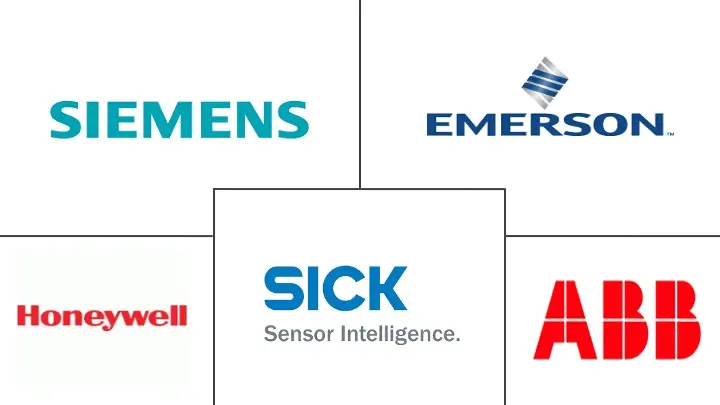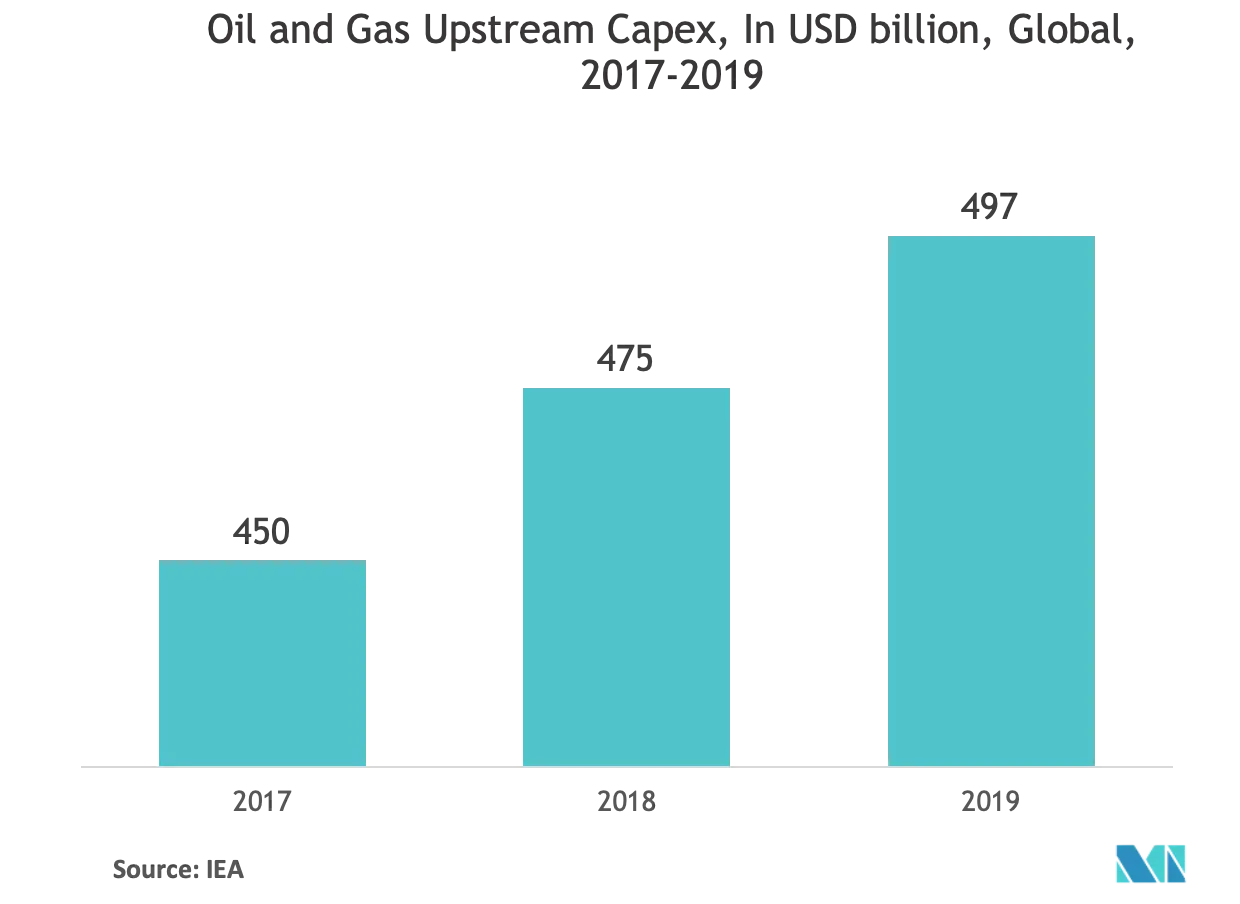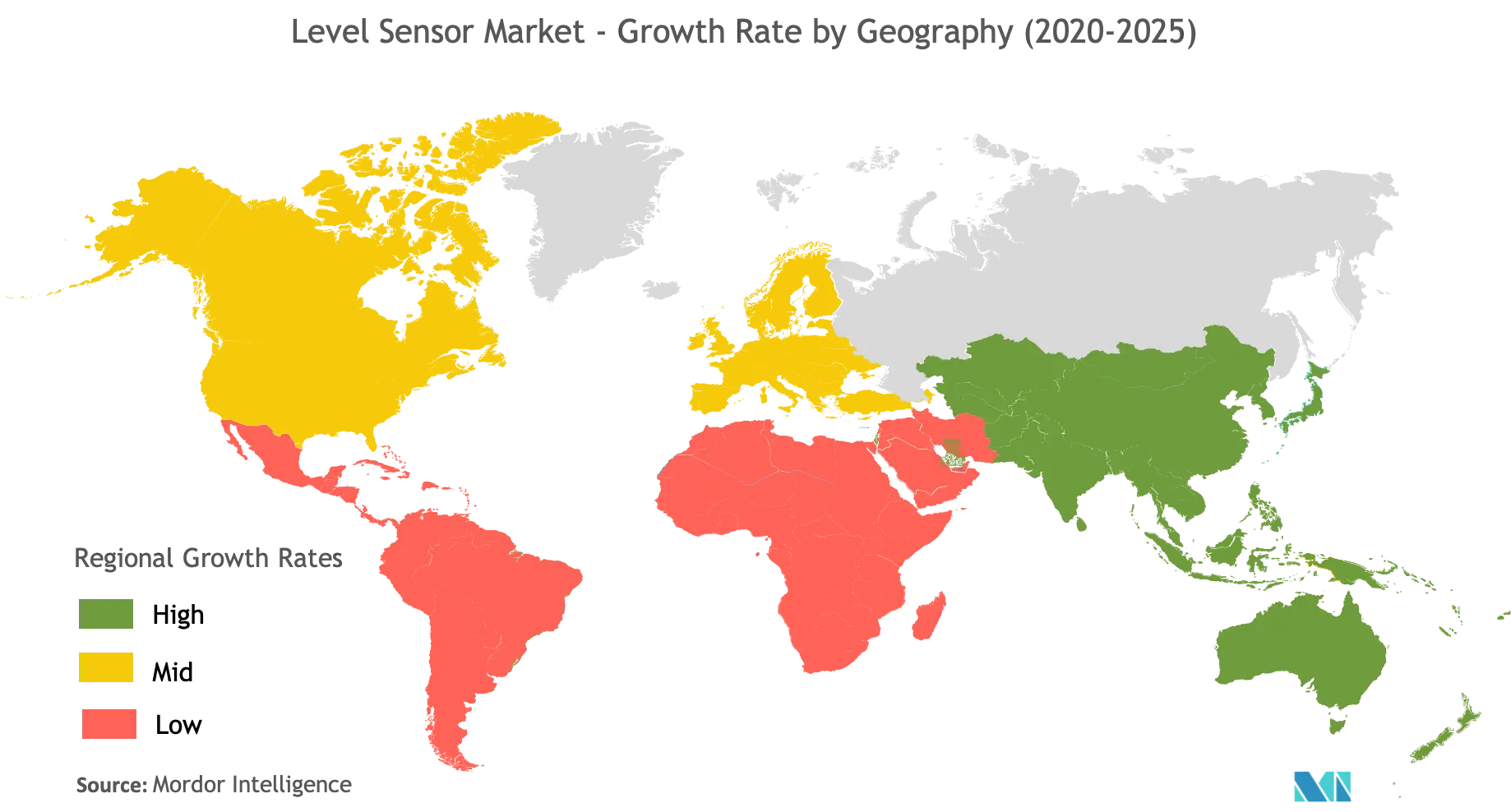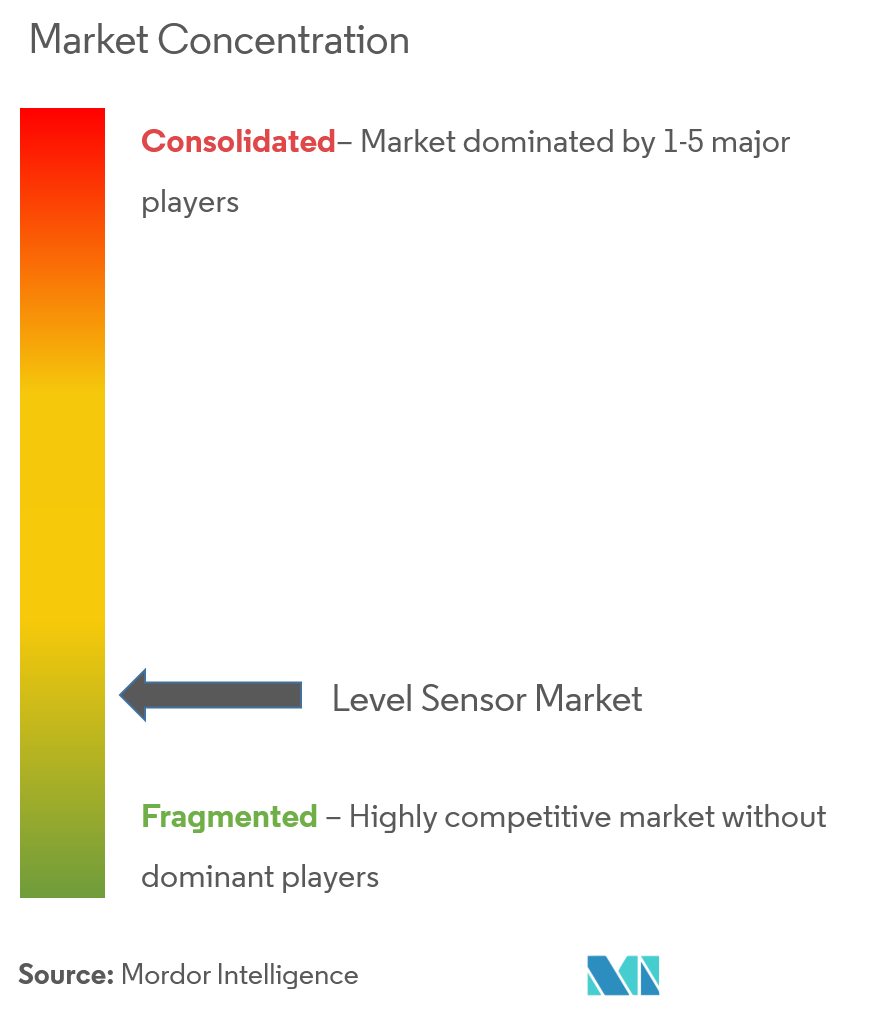Level Sensors Market Size

| Study Period | 2019 - 2029 |
| Base Year For Estimation | 2023 |
| CAGR | 10.06 % |
| Fastest Growing Market | Asia Pacific |
| Largest Market | North America |
| Market Concentration | Low |
Major Players
*Disclaimer: Major Players sorted in no particular order |
Level Sensors Market Analysis
The level sensors market was valued at USD 4.38 billion in 2020 and is expected to reach a value of USD 7.45 billion by 2026, registering a CAGR of 10.06% over the forecast period of 2021-2026. The growing needs of Industry 4.0 and the Industrial Internet of Things (IIoT) led to an increased requirement of diagnostics and mobile-led access. Level sensors are becoming a major choice for automation in industries with large-scale manufacturing and storage of liquids or powdered materials.
- Similarly, owing to the growing demand for intelligent sensors to equip microprocessors, higher accuracy, efficiency, easy installation and maintenance, and provision of greater visibility of the performance of the machine/instrument, the development and integration capabilities of level sensors are being focused upon.
- Furthermore, initiatives, such as the Building Research Establishment's Environmental Assessment Method (BREEMA) by the United Kingdom, Leadership in Energy and Environmental Design (LEED) in the United States, and Deutsche Gesellschaft für Nachhaltiges Bauen (DGNB) by Germany, are encouraging the installation of level sensors, especially point level sensors, globally.
- These sensors play a crucial role in effluent tanks for wastewater, distribution tanks for clean water, and pump stations for irrigation systems. The stringent regulations in the developed regions, such as the United States, the United Kingdom, and Germany, in addition to the measures that support the government initiatives, are anticipated to increase the adoption of water treatment technologies.
- The ability to offer higher accuracy, efficiency, easy installation, and maintenance is anticipated to drive the level of sensor market growth. Additionally, vendors have been resorting to significant developments in terms of product launches, which have been suggestive of the same.
- For instance, Madison launched a miniature version of a continuous float level sensor by keeping the advantages of a ruggedized reed switch-based technology, for applications with a small tank footprint. Likewise, for applications across water and wastewater, fuel/oil measurement, and storage and dispensing silos, the company launched U5098 ultrasonic sensors as a non-contact version.
- With the onset of COVID-19, multiple end-user industries in the market studied have been affected due to reduced operations, temporary factory closures, etc. In the renewable energy industry, major concerns revolve around global supply chains, which are considerably slowing down production, aiming for reduced spending for new measurement systems and sensors.
Level Sensors Market Trends
This section covers the major market trends shaping the Level Sensor Market according to our research experts:
Oil and Gas Sector to be the Largest User of Level Sensors
- The oil and gas sector is one of the most significant end users of level sensors, globally. The extensive use of these sensors for monitoring storage units and downstream processing plants has maintained a constant demand for level sensors from the sector. With the growing crude oil production in some countries, such as the United States, the need for level sensors is expected to increase.
- Alternatively, as per the International Energy Agency, the Asia-Pacific region emerged as the highest importer and consumer of natural gas. China alone accounted for two-thirds of the demand for natural gas globally. The region is not joined by a high-pressure pipeline as much as the other areas, owing to which the transport is more susceptible to leakages. Thus, there is a constant requirement of monitoring during transportation.
- According to British Petroleum's Statistical Review of World Energy, 2018, more than 33% of the global refining capacity is concentrated in the Asia-Pacific region. Countries like China, India, Japan, and South Korea have the most active oil and downstream gas sectors in the region, which, together, are responsible for over 78% of the Asia-Pacific oil refining capacity region. This is suggestive of an opportunity across the creation of a new application. Furthermore, the demand from the midstream and downstream sectors is expected to increase significantly.
- In January 2020, the Union Cabinet of India approved a memorandum of understanding (MoU) on co-operation in the oil and gas sector. As part of the MoU, the two countries may focus on exploration and production (E&P) and liquefied natural gas (LNG) opportunities. Both India and Brazil may also focus on R&D in the energy sector.
- Fluid sensing in the oil and gas sector is very important. Water, chemical fluids, and oils are integral throughout the lifecycle of a well, and even more with the rising activity in drilling techniques, like hydraulic fracturing. New techniques and regulations have further added to the need for monitoring a wide range of chemicals, along with processing flow back and produced wastewater.

North America to Account for the Largest Share
- Driven by the increased investments in automation and focus on the efficiency of processes across the pharmaceutical, oil, and gas, and food processing industries, North America is expected to be the largest market.
- Several technologies are used in the North American level sensor market. The ultrasonic form is one of the most popular techniques due to the small size of sensors and mobility. The sensors are also easy to use and affordable. The sensors do not require much maintenance. The ultrasonic sensors are mainly used to measure solid substances and the ability to function in extreme conditions.
- As the US Department of the Interior’s (DoI) plans to allow offshore exploratory drilling in about 90% of the Outer Continental Shelf (OCS) acreage under the National Outer Continental Shelf Oil and Gas Leasing Program (National OCS Program) for 2019-2024, the regional oil and gas sector is expected to open up new opportunities for the level sensor market.
- Moreover, vendors in the region are investing in expanding their product portfolio to cater to the growing demands. For instance, in October 2019, OMNICOMM launched two additions to its fuel-level sensor line, namely, OMNICOMM LLS 5 and its explosion-proof version, OMNICOMM LLS-Ex 5. The portfolio features an ingress protection rating, designed for use in hazardous areas.

Level Sensors Industry Overview
The level sensors market is highly fragmented. The market is witnessing a trend of acquisition of small technology vendors by the major players, along with the intense competition due to the demand for highly efficient products among the players. Some of the recent developments in the market are:
- In December 2019 - VEGA added a new compact 80 GHz instrument series to its portfolio of radar-based sensors for level measurement. Explicitly designed in line with price-sensitive applications, such as the water/wastewater industry or in auxiliary process loops in process automation, radar is characterized by its extremely small size, fast start uptime, and low energy consumption.
- In April 2019 - Emerson acquired Bioproduction Group, a leader in simulation, modeling, and scheduling software for biomanufacturing. Bio-G's scheduling and modeling systems, combined with Emerson's extensive life science technology and expertise portfolio, will help the companies bring therapies for cancer, diabetes, and other illnesses to the patients.
Level Sensors Market Leaders
-
ABB Ltd
-
Sick AG
-
Honeywell International Inc.
-
Emerson Electric Co.
-
Siemens AG
*Disclaimer: Major Players sorted in no particular order

Level Sensors Market Report - Table of Contents
1. INTRODUCTION
- 1.1 Study Deliverables
- 1.2 Study Assumptions
- 1.3 Scope of the Study
2. RESEARCH METHODOLOGY
3. EXECUTIVE SUMMARY
4. MARKET INSIGHTS
- 4.1 Market Overview
-
4.2 Industry Attractiveness - Porter's Five Force Analysis
- 4.2.1 Bargaining Power of Suppliers
- 4.2.2 Bargaining Power of Buyers/Consumers
- 4.2.3 Threat of New Entrants
- 4.2.4 Threat of Substitute Products
- 4.2.5 Intensity of Competitive Rivalry
- 4.3 Assessment of COVID-19 Impact on the Level Sensor Market
5. INDUSTRY VALUE CHAIN ANALYSIS
6. MARKET DYNAMICS
- 6.1 Introduction to Market Dynamics
-
6.2 Market Drivers
- 6.2.1 Increasing Focus on Industrial Process Control
- 6.2.2 Growing Advancement of the IIoT and Industry 4.0
-
6.3 Market Challenges
- 6.3.1 Technical Issues Related to Accuracy
7. MARKET SEGMENTATION
-
7.1 By Monitoring Type
- 7.1.1 Point Level Sensors
- 7.1.1.1 Mechanical and Magnetic Float Level Sensors
- 7.1.1.2 Capacitance Level Sensors
- 7.1.1.3 Vibratory Probe Level Sensors
- 7.1.1.4 Conductivity Level Sensors
- 7.1.1.5 Other Point Level Sensors
- 7.1.2 Continuous Level Sensors
- 7.1.2.1 Laser Level Sensor
- 7.1.2.2 Ultrasonic Level Sensors
- 7.1.2.3 Magnetostrictive Level Sensors
- 7.1.2.4 Radar Level Sensors
- 7.1.2.5 Other Continuous Level Sensors
-
7.2 By End-user Industry
- 7.2.1 Power Generation
- 7.2.2 Oil and Gas
- 7.2.3 Mining and Metal Processing
- 7.2.4 Food and Beverage
- 7.2.5 Chemical
- 7.2.6 Water and Wastewater
- 7.2.7 Other End-user Industries (Pharmaceutical, Cement, Paper and pulp industry, etc.)
-
7.3 Geography
- 7.3.1 North America
- 7.3.1.1 United States
- 7.3.1.2 Canada
- 7.3.2 Europe
- 7.3.2.1 United Kingdom
- 7.3.2.2 Germany
- 7.3.2.3 France
- 7.3.2.4 Rest of Europe
- 7.3.3 Asia-Pacific
- 7.3.3.1 China
- 7.3.3.2 India
- 7.3.3.3 Japan
- 7.3.3.4 Rest of Asia-Pacific
- 7.3.4 Latin America
- 7.3.5 Middle East & Africa
8. COMPETITIVE LANDSCAPE
-
8.1 Company Profiles (Overview, Business Segments, Key Products and Strategies, SWOT Analysis, and Recent Developments)
- 8.1.1 ABB Ltd
- 8.1.2 Sick AG
- 8.1.3 Vega Grieshaber KG
- 8.1.4 BinMaster Inc.
- 8.1.5 Emerson Electric Co.
- 8.1.6 Baumer Group
- 8.1.7 Honeywell International Inc.
- 8.1.8 Endress + Hauser AG
- 8.1.9 First Sensor AG
- 8.1.10 TE Connectivity Ltd
- 8.1.11 Siemens AG
- 8.1.12 Georg Fischer AG
9. INVESTMENT ANALYSIS
10. FUTURE OF THE MARKET
** Subject To AvailablityLevel Sensors Industry Segmentation
Level sensors are used to determine the level of free-flowing substances that are of utmost importance in commercial and industrial applications. Moreover, the level sensors are available in different sizes and variety and are designed using different sensing techniques to meet various requirements.
| By Monitoring Type | Point Level Sensors | Mechanical and Magnetic Float Level Sensors |
| Capacitance Level Sensors | ||
| Vibratory Probe Level Sensors | ||
| Conductivity Level Sensors | ||
| Other Point Level Sensors | ||
| By Monitoring Type | Continuous Level Sensors | Laser Level Sensor |
| Ultrasonic Level Sensors | ||
| Magnetostrictive Level Sensors | ||
| Radar Level Sensors | ||
| Other Continuous Level Sensors | ||
| By End-user Industry | Power Generation | |
| Oil and Gas | ||
| Mining and Metal Processing | ||
| Food and Beverage | ||
| Chemical | ||
| Water and Wastewater | ||
| Other End-user Industries (Pharmaceutical, Cement, Paper and pulp industry, etc.) | ||
| Geography | North America | United States |
| Canada | ||
| Geography | Europe | United Kingdom |
| Germany | ||
| France | ||
| Rest of Europe | ||
| Geography | Asia-Pacific | China |
| India | ||
| Japan | ||
| Rest of Asia-Pacific | ||
| Geography | Latin America | |
| Middle East & Africa |
Level Sensors Market Research FAQs
What is the current Level Sensor Market size?
The Level Sensor Market is projected to register a CAGR of 10.06% during the forecast period (2024-2029)
Who are the key players in Level Sensor Market?
ABB Ltd, Sick AG, Honeywell International Inc., Emerson Electric Co. and Siemens AG are the major companies operating in the Level Sensor Market.
Which is the fastest growing region in Level Sensor Market?
Asia Pacific is estimated to grow at the highest CAGR over the forecast period (2024-2029).
Which region has the biggest share in Level Sensor Market?
In 2024, the North America accounts for the largest market share in Level Sensor Market.
What years does this Level Sensor Market cover?
The report covers the Level Sensor Market historical market size for years: 2019, 2020, 2021, 2022 and 2023. The report also forecasts the Level Sensor Market size for years: 2024, 2025, 2026, 2027, 2028 and 2029.
Level Sensors Industry Report
Statistics for the 2024 Level Sensors market share, size and revenue growth rate, created by Mordor Intelligence™ Industry Reports. Level Sensors analysis includes a market forecast outlook to 2029 and historical overview. Get a sample of this industry analysis as a free report PDF download.



